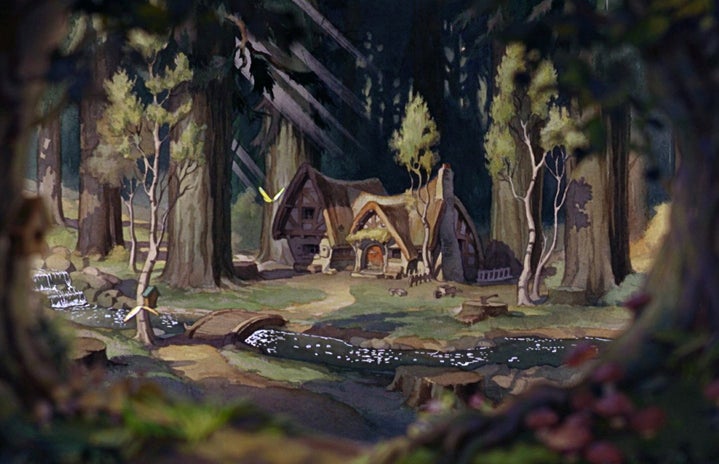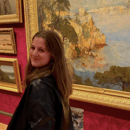I’m just kidding. I don’t think that liking Kinkade’s work is necessarily indicative of having a bad taste in art. But even if it were, my friends tend to steer clear of my favorite art and music, so be comforted that you are not alone in your poor preferences.
You might not think you know about Thomas Kinkade, but you do. Even before I studied art history or learned his name, I noticed his paintings everywhere. He is best known for his romantic landscapes with idyllic cottages, ethereal forests, and vibrant florals. To many, his work has become the prime example of kitsch within the art world.
However, for most of his career, Thomas Kinkade was not “kitsch.” He was wildly successful. Art critics have pointed to his marketing techniques as the cause for this success and renown. Rather than selling paintings like his contemporaries, Kinkade sold high-quality digital photolithographic reproductions of his paintings. In fact, many of his artistic choices were influenced by the need for his art to look good after being digitally reproduced. For example, his vibrant and bright color palette definitely serves the blissful and romantic landscapes, but it also creates sharp value contrasts for clarity when making prints. So while other artists were selling only one copy of each painting, Kinkade was selling millions of copies of the same painting. Every painting made by Kinkade was mass-produced and made accessible to anyone who wanted one. According to Kinkade’s company, 1 in every 20 American homes owns a copy of one of his paintings.
Kinkade’s utilization of mass-produced art normally would have made his work less valuable. If everyone could have a Picasso or a Pollock, they probably would not be as coveted as they are. But everyone can have a Kinkade in their home, which is why the artist had to devise a marketing strategy to convince his buyers that there was still a sense of rarity in owning his art. First, he set arbitrary restrictions on the number of prints for each painting, labeling them as “limited editions.” This practice of “limited editions” was not nuanced for the art world at this time, but Kinkade took it a step further by creating a hierarchy of ridiculously titled editions. For each painting Kinkade produced, a consumer could purchase either a Standard Numbered Edition, an Artist Proof Edition, a Gallery Proof Edition, a Publisher Proof Edition, an International Proof Edition, a Renaissance Edition, a Studio Proof Edition, or a Master Edition. With each step up the limited-edition pyramid, Kinkade gives the prints certain exclusive touches, such as signatures, numbers, and hand-painted highlights on the printed canvas. As the prints become more and more “exclusive,” they grow in price, making them feel authentic and rare to art audiences even though in truth they are not. What Henry Ford was to cars, Thomas Kinkade was to art. The process of making and selling art became simplified as factories poured out millions of printed canvases, stretched them, framed them, and shipped them to galleries in minutes.
Speaking of galleries, Thomas Kinkade invested in hundreds of galleries across the United States, known as “Thomas Kinkade Signature Galleries,” each one selling only his framed limited edition prints. The galleries were meant to be welcoming and warm environments, a stark contrast to typical cold, white-walled, high-art galleries. Likewise, Kinkade did not hire art experts or individuals with art education to work in these galleries, rather, just people who enjoyed art. In this way, interested buyers would not feel alienated walking into an environment that was usually reserved for people who “understood” art (which is a whole different conversation). These strategies worked for him, and he quickly grew into a household name and a common household decoration.
With that being said, I think his art is “bad art.” This opinion is not to be confused with Kinkade’s skill as an artist. His paintings are technically good. His cottages look like cottages, his skies look like skies, and everything he paints is beautiful and comforting, just like he intends. My problem with his artwork, and my controversial opinion, stems from his failure to make art that in any way interacts with the needs of society beyond hanging on our walls.
Kinkade likely intends to do what all artists intend to do: capture a collective social, political, and cultural unconscious. He connects himself to artists such as Normal Rockwell, the Romantics, and even the Impressionists in terms of style and aesthetic. This means that he himself must be aware of art tradition and history. However, where those artists interact with and subvert the desires of their audiences through unexpected artistic vernaculars, Kinkade merely commercializes art that he knows will placate the masses.
For example, when we look at a Thomas Kinkade painting, such as Hometown Pride, (above) we see a bright and comforting upper-middle class American home. An American flag flies on the porch; flowers blossom along a clear sidewalk. All the lights are on, and the sun shines through a canopy of leaves. For many, this image instills a sense of sentimentality and solace; we can envision our own families living in this house. All of this is Kinkade’s intention. His paintings are so non-specific that they aim to speak to everyone. In doing so, they say nothing beyond surface value. To me, they sometimes come across as blatantly capitalistic and nationalistic, marketed to audiences as pharmaceutical-like relief from the pressures of everyday life, while failing to actually provide that service.
Of course, I could be totally wrong. Maybe in 50 years, art critics will deduce that Thomas Kinkade provided society with exactly what we needed at the time, similar to how Marcel Duchamp’s Fountain responded to the chaos and absurdism of World War I. In that case, I would respectfully like to retract all of my previous sentiments.
This is probably a horrible admission for me to make, but my first contact with Thomas Kinkade was actually not in the classroom or in the art world, but on Netflix’s Bojack Horseman. Despite the fact that it’s an adult cartoon, one episode makes insightful mention and critique of Thomas Kinkade that has influenced how I view and appreciate art.
There is a fight scene in a fine art gallery at the strip mall occurring between character actress Margot Martindale and gallery security. One of the main characters, Princess Carolyn, who is known as a stressed-out workaholic, finds herself in the middle of the mess. In the midst of the cartoonish violence happening around her, she sees a Thomas Kinkade painting hanging on the wall. Drawn in by its soothing ambiance, she is distracted from the ongoing conflict and imagines herself as the carefree inhabitant of the painted cottage in the woods. The critique comes from the fact that Kinkade’s invited escapism and conformity is not a real solution to the problems around us, and the idyllic scene is actually not a sustainable image for quelling our anxieties. Princess Carolyn becomes anxious of her imagined peace, and is relieved to be back in reality, even though her reality was an absurd shoot-out in an art gallery.
It could definitely be a little bit of a stretch to call Kinkade’s work “bad” or “socially irresponsible” just because of his proposed idyllic dreamscapes, but it is true that they begin to blend together in their vagueness and lack of nuance. I think that art should be accessible, and ultimately there is nothing wrong with Kinkade selling mass-produced prints if it means that everyone gains the ability to display art in their home. But I also think that art should goad its audience into thinking deeper, and Kinkade’s work doesn’t do that. The masses deserve better!



![Controversial? Liking Thomas Kinkade's Art Could Be A Sign of Bad Taste :( 3 [all shouting]](https://i0.wp.com/y.yarn.co/7980e085-c989-49f4-a9b0-b30d1f8c49b4_text.gif?resize=640%2C360&ssl=1)